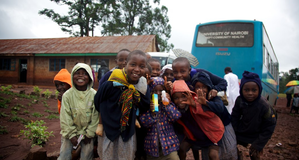Featured Article:Maternal Mortality in Nepal: Addressing the IssueIn the NDHS database, mother’s highest educational level is categorized into four categories: No education, Primary, Secondary and Higher. Chi-square analyses showed a significant association between mother’s highest educational level and PC status in pf women (χ2 = 398.20, p = <.001). Furthermore, the percentage of mothers who received PC showed an increasing trend with increasing level of education. In the four education groups – no education, primary, secondary and higher – the percentage of mothers who received PC were 61.2%, 80.5%, 92.5% and 100% respectively. Hence, only 5.5% of women with higher than secondary level of schooling did not receive PC, in comparison to 82% of women with no education. Ecological zone (Mountain, Hill, Terai) was also significantly associated with whether or not the women received PC (χ2 = 117.015, p = <.001). Mothers who were living in the Mountain region were least likely to receive PC, and those who were living in the Terai Region were most likely to receive PC, with mothers who were living in the Hill region falling in between. 39.2% of women in the Mountain region reported having received no PC in comparison to 32.7% and 20.1% of mothers living in the Hill and Terai region respectively. Similar relation was seen between women living in different development regions of Nepal (Eastern, Central, Western, Mid-Western, Far-western) (χ2 = 45.58, p = <.001). Analysis showed Eastern Region had the largest proportion of women (78.7%) who reported having received PC. The Mid-western Region showed the lowest proportion of women (64.4%) who reported having received PC. There were no considerable differences in the proportions of two PC status groups between Western and Far-western groups. There was a stronger significant association between the type of place of residence (urban vs. rural) and PC status (χ2 = 114.98, p = <.001). Consistent with what we would expect, a greater proportion (85.5%) of women who lived in the urban region reported having received PC in comparison to 68.1% of women who lived in the rural region. DHS wealth index quintile distribution (poorest, poorer, middle, richer, richest) was significantly associated with PC status (χ2 = 494.85, p = <.001). As we expected, there was perfect linear trend in the proportion of ‘received PC’ group among the increasing quintiles of wealth index. The ‘Richest’ group, had the highest proportion (93.5%) of women who reported received PC, followed by the ‘Richer’ group (84.9%) of women who reported having received PC. The percentage of women who reported having received PC in the first three quintiles (Poorest, Poorer, Middle) was 50.2%, 68.9% and 76.3% respectively.Religion (Hindu, Buddhist, Muslim, Kirat, Christian or other) was also found to be associated with PC status (χ2 = 30.56, p = <.001). Christian women were most likely to seek PC (81.1%) whereas Buddhist women were less likely to have received PC (59%). Similarly, survival status of last child was significantly associated with the status of PC among women (χ2 =16.18, p = 0.<.001). Interestingly, the percentage of women having received PC was greater among those who had the last child alive (88%) than those whose last child were dead (72.8%). Also, the type of native language spoken by the women was significantly associated with their PC status (χ2 =145.02, p = 0.<.001). In contrast to our hypothesis, women speaking Maithili were more likely to have received PC (85.8%) than women speaking Nepali, national language (76.7%). Three groups of variables related to Knowledge, Attitude and Practice were analyzed to investigate whether or not these variables have any association with Nepalese women receiving PC. The first group included variables that measured knowledge status of women, including heard about family planning (through radio, TV or newspaper) and whether or not women know where to get abortion. Opinion of women in terms of desire for more children and whether or not wanted last child were included in the ‘attitude’ group. Smoking habit (including cigarettes, pipe, snuff, chewing tobacco or other), use of cesarean section, preparation for delivery (including saved money, arranged transportation, found blood donor, contacted health worker, bought safe delivery kit, prepared food and clothes), use of special safe delivery kit, total pregnancies and use of iron/folic acid tablet were included in the ‘practice’ cluster. Within ‘knowledge’ variables, women who had heard about family planning was significantly associated with PC status (χ2 = 117.67, p = <.001). As expected, 76.9% of women who said that they have heard about family planning from radio, TV or newspaper received PC, in comparison to 60.1% in women who said that they have not heard about family planning from none of the sources. Similarly, whether or not the women had knowledge about where to get an abortion was strongly associated with PC status (χ2 = 185.68, p = <.001). 80.2% of women who were aware of place to have abortion have received PC compared to 64.1% of women who did not know about the place to get an abortion. Furthermore, the proportion of women who reported having received PC was the lowest (57%) when the respondents had no knowledge of where to get an abortion. In terms of ‘attitude’, both women’s desire for more children (χ2 = 74,45, p = <.001), and women wanting the last child (χ2 = 105.48, p = <.001) were significantly associated with PC utilization. Surprisingly, the proportion of women who reported having received PC was higher (83.6%) among women who desired more children after more than two years than those who wanted within two years (67%). The proportion of women who have received PC was the lowest (55.6%) among women who wanted more children but were unsure about the timing. Contrary to our expectation, women who wanted their last child ‘later’ (81.3%) had higher proportion to have received PC than women who wanted their last child ‘then’ (74.4%), whereas, the proportion of having received PC among women who did not want last child was 58.9%. Similarly, in the ‘practice’ variables group, total number of pregnancies (t(4182)=17.6, p=<.001) was significantly associated with PC status of women. Women whether or not smoked (χ2 = 228.25, p = <.001) had strong relationship with the status of PC. The proportion of PC status was much higher among women who did not smoke (77.5%) compared to women who smoked (51.3%). Also, use of caesarean section (χ2 = 33.183, p = <.001) to deliver child was strongly associated with PC status. Interestingly, 96.4% of women who used C-section during delivery reported receiving PC in comparison to 71.6% in women who did not use C-section. Likewise, preparation for delivery (χ2 = 268.95, p = <.001) for example, saved money, arranged transportation, contacted health worker, found blood donor, bought safe delivery kit and clothes and prepared food, was significantly associated with PC status of women. The majority (83.3%) of women who made preparation for delivery did receive P, whereas only 60.3% of women who did not make preparation received PC. Finally, both the variables, ‘special safe delivery kit used’ (χ2 = 194.3, p = <.001) and ‘iron/folic acid tabled used’(χ2 =252.96, p = <.001), showed significant relationship with the PC status. 62.1% of mothers reported to have received PC who did not use special safe delivery, in comparison to 93.6% of women who did not use special safe delivery kit. Similarly, the proportion of use of PC was much higher among women who used iron/folic acid tablet during pregnancy (94.2%) than women who did not use (66.7%). Intervention PlansOf all health indicators in Nepal, maternal mortality reveals the greatest gap between rich and poor, women residing in rural and urban areas and uneducated and educated women. Previous studies have shown that interventions to increase utilization of PC significantly help to reduce this gap of maternal death. A countrywide analysis of 2006 NDHS data showed that perceived barriers to utilization of PC, such as access to MHS, knowledge about PC, family barrier, transportation and the distance to health facility significantly explained why Nepalese women did not receive PC. These results suggest that increasing awareness on PC through mass media and focus groups, educating other influential members in the family (husbands, mother-in-laws) about PC and increasing access to MHS in healthcare facilities may have a significant impact on improving utilization rates for PC. The application of our multilevel intervention designed to increase utilization of PC among women is stratified into two levels 1) Organizational level and 2) Population level. This collaborative interventional approach from both levels will primarily focus on increasing awareness on PC use among women and their families.Continued on Next Page » Suggested Reading from Inquiries Journal
Inquiries Journal provides undergraduate and graduate students around the world a platform for the wide dissemination of academic work over a range of core disciplines. Representing the work of students from hundreds of institutions around the globe, Inquiries Journal's large database of academic articles is completely free. Learn more | Blog | Submit Latest in Health Science |
















